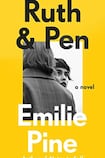
A contemporary Dublin Mrs Dalloway? Not a bad idea by any means. Virginia Woolf’s masterpiece is set, you will recall, in London on a single day, June 13th, 1923. (A critic recently suggested that we should mark this day as festively as we mark Bloomsday – perhaps, in this case, by throwing parties attended by the British prime minister or by inducing traumatic flashbacks to the first World War.)
The action of Ruth & Pen, Emilie Pine’s debut novel, also takes place on a single day, in this case September 20th, 2019, the day of the climate strike protest in Dublin. Like Mrs Dalloway, it follows two unrelated characters through their waking hours; in this case, Ruth Ryan, a psychotherapist, and Pen, who is 16 and, as her friend Alice puts it, “on the spectrum”.
Ruth, as the novel opens, awakens into the stream of her own consciousness, which jumbles up the banal and the serious, as waking thoughts tend to do: “In the bathroom she flicks on the light, sits to pee, and automatically checks her underwear. No blood. Silent thanks. She will report this to the hospital later. All fine! Only a check-up!” Ruth is alone in the house. Her husband, Aidan, is in London. Their marriage hangs in the balance. After four rounds of IVF, Ruth has not conceived. Both are grieving “the children we did not have”; in their grief, they have drifted apart. Today – an ordinary workday – they will either split or reconcile.
Meanwhile, Pen is checking her phone in bed: “Two girls kissing on Instagram.” Today she will skip school to attend the climate protest with Alice, her best friend, whom Pen wants to kiss. Pen is autistic. Faces and idioms confuse and intrigue her. “Today she will take Alice’s hand and maybe she won’t even need to speak, maybe the gesture will be enough, they’ve held hands before, but that seems so innocent now, back before they were… (What are they?)” Ruth and Pen, strangers to each other, will meet only briefly, though not inconsequentially.
Ruth & Pen follows Pine’s hugely successful collection of personal essays Notes to Self (2019). What made those essays so remarkable was their unmanipulative honesty. She chronicled her painful relationship with her father; her hedonic teenage years; the stillbirth of her sister’s child, and her own struggles to conceive in such a way that readers recognised their own experiences in her pages and found themselves moved and affirmed by the clarity of her telling.
A similar clarity marks the prose of Ruth & Pen, though the move to fiction, and the looming shadow of Virginia Woolf, do tend to make us aware of a certain plainness in the sentences. There is nothing here, for instance, to match the “thick ruffled bar of white smoke” that Woolf’s Westminster crowd sees trailed by a skywriting aeroplane, or the “leaden circles” of sound produced by Woolf’s Big Ben; there is no minor character notated with the brilliance that Woolf affords the florist, “button-faced Miss Pym, whose hands were always bright red, as if they had been stood in cold water with the flowers”.
As Ruth passes Brown Thomas, she sees “all its expensive, shiny things”; the window of Avoca similarly contains “brightly coloured blankets”. By contrast, Clarissa Dalloway notes in the window of Hatchards’ bookshop the titles of individual books, among them Soapy Sponge and Big Game Shooting in Nigeria. Material specificity is what gives novelistic prose traction. “Expensive, shiny things” and “brightly coloured blankets” are vague (what things, precisely? Which colours?). Deprived of material specificity, Pine’s prose must find its traction elsewhere.
What does animate the novel, and the prose, is Pine’s capacity for empathy. She is less interested in describing precisely the outer world than she is in inhabiting faithfully the inner one. She honours, therefore, in Ruth’s chapters, the ordinary trundlings of consciousness – the griefs that surface during lunch with a friend, the random occurrences of memory provoked by particular streets. And she honours also the uniqueness of Pen’s mind, with its passion for order and its frustrated need for connection. Pine’s goodwill towards her characters is her most distinctive quality, as a novelist. She is ready to empathise with everyone, and she is ready to help us empathise with everyone, too.
There are some other faults – the climate change theme isn’t really dramatised, except for one rather good moment (again echoing Mrs Dalloway) in which Pen envisions a devastated planet; the climactic scene between Ruth and Aidan feels a bit stagey. But there’s no doubting the novel’s basic integrity; its warmth, its undogmatic interest in ordinary lives, and the impressive range of its imaginative sympathies.
Kevin Power’s White City is out now in paperback from Scribner UK.












